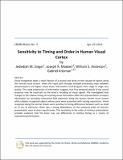Sensitivity to Timing and Order in Human Visual Cortex.
Author(s)
Singer, Jedediah M.; Madsen, Joseph R.; Anderson, William S.; Kreiman, Gabriel
DownloadCBMM-Memo-005.pdf (1.123Mb)
Terms of use
Metadata
Show full item recordAbstract
Visual recognition takes a small fraction of a second and relies on the cascade of signals along the ventral visual stream. Given the rapid path through multiple processing steps between photoreceptors and higher visual areas, information must progress from stage to stage very quickly. This rapid progression of information suggests that fine temporal details of the neural response may be important to the how the brain encodes visual signals. We investigated how changes in the relative timing of incoming visual stimulation affect the representation of object information by recording intracranial field potentials along the human ventral visual stream while subjects recognized objects whose parts were presented with varying asynchrony. Visual responses along the ventral stream were sensitive to timing differences between parts as small as 17 ms. In particular, there was a strong dependency on the temporal order of stimulus presentation, even at short asynchronies. This sensitivity to the order of stimulus presentation provides evidence that the brain may use differences in relative timing as a means of representing information.
Date issued
2014-04-25Publisher
Center for Brains, Minds and Machines (CBMM), arXiv
Citation
arXiv:1404.6420v1
Series/Report no.
CBMM Memo Series;005
Keywords
Neuroscience, Ventral Visual Stream, Vision, Pattern Recognition
Collections
The following license files are associated with this item: